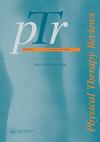调查50岁及以上成年人参与体育活动的障碍:一项范围审查
IF 0.8
Q4 REHABILITATION
引用次数: 0
摘要
摘要背景:解决体力活动障碍对于提高中老年人的PA水平至关重要。然而,在选择PA屏障评估工具方面没有建议。因此,我们的目的是确定并提供PA障碍评估工具的临床特性,医疗保健提供者、运动专家和公共卫生官员可以使用这些工具来检查50岁及以上社区居民面临的潜在障碍。方法系统检索PubMed、PsycINFO、CINAHL和Web of Science数据库。如果文章提供了平均年龄在50岁及以上的社区居民参与PA障碍评估工具的临床数据,则纳入。561篇确定的文章进行了多轮盲法评价。对纳入的文章进行了参与者特征、评分、结构、参考测试和临床特性的数据提取。结果纳入的35篇文章报道了33种不同的PA参与障碍评估工具。18篇文章报道了心血管、肌肉骨骼或神经系统诊断、糖尿病、血液透析、癌症史或活动受限的参与者。有两种或两种以上支持出版物的工具包括运动益处/障碍量表(EBBS)、运动量表(ESIE)和身体活动和障碍量表(IPAB)。由于方法上的差异,跨工具比较是不可能的。结论EBBS、ESIE和IPAB是50岁及以上社区居民的有效工具。然而,在50岁及以上的成年人中,需要进一步的研究来确定最佳的PA屏障评估工具。我们要感谢佛蒙特大学图书管理员Nancy Bianchi的贡献,她指导我们确定了合适的搜索词并完成了搜索。披露声明作者未报告潜在的利益冲突。额外的informationFundingDr。Vincenzo由转化研究所(TRI)资助,资助(KL2;TR003108和UL1 TR003107)通过国家卫生研究院推进转化科学中心和国家老龄化研究所的K76AG074920获得。本文章由计算机程序翻译,如有差异,请以英文原文为准。
Examining physical activity participation barriers among adults 50 years and older: a scoping review
AbstractBackground Addressing physical activity (PA) barriers is essential for increasing PA levels in middle-aged and older adults. However, there are no recommendations on selecting PA barrier assessment tools.Objectives Thus, we aimed to identify and provide clinimetric properties on PA barrier assessment tools that healthcare providers, exercise experts, and public health officials can use to examine potential barriers faced by community-dwelling adults 50 years and older.Methods We performed a systematic search of the following databases: PubMed, PsycINFO, CINAHL, and Web of Science. Articles were included if they presented clinimetric data on a PA participation barrier assessment tool for community-dwelling participants with a mean age of 50 years and older. The 561 identified articles underwent multiple rounds of blinded reviews. Included articles underwent data extraction for participant characteristics, scoring, constructs, reference tests, and clinimetric properties.Results The 35 included articles reported on 33 different PA participation barrier assessment tools. Eighteen articles reported on participants with cardiovascular, musculoskeletal, or neurological diagnoses, diabetes, hemodialysis, history of cancer, or mobility limitations. Tools with two or more supporting publications included the Exercise Benefits/Barrier Scale (EBBS), Episode-Specific Interpretations of Exercise Inventory (ESIE), and Inventory of Physical Activity and Barriers (IPAB). Due to differences in methodologies, across-tool comparison was not possible.Conclusion The EBBS, ESIE, and IPAB are promising tools for community-dwelling adults 50 years and older. However, additional research is warranted to identify the best PA barrier assessment tool among adults 50 years and older.Keywords: Physical activitybarriersolder adultsprimary prevention AcknowledgementsWe would like to acknowledge the contributions made by Nancy Bianchi, a librarian at the University of Vermont, for her guidance on identifying appropriate search terms and for completing the searches.Disclosure statementNo potential conflict of interest was reported by the authors.Additional informationFundingDr. Vincenzo was supported by the Translational Research Institute (TRI), grant (KL2; TR003108 and UL1 TR003107) through the National Center for Advancing Translational Sciences of the National Institutes of Health and K76AG074920 from the National Institute on Aging.
求助全文
通过发布文献求助,成功后即可免费获取论文全文。
去求助
来源期刊

Physical Therapy Reviews
REHABILITATION-
CiteScore
1.30
自引率
0.00%
发文量
26
期刊介绍:
Physical Therapy Reviews is an international journal which aims to publish contemporary reviews, discussion papers and editorials within physical therapy, and in those basic and clinical sciences which are the basis of physical therapy. The journal is aimed at all those involved in research, teaching and practice within the area of physical therapy. Reviews (both descriptive and systematic) are invited in the following areas, which reflect the breadth and diversity of practice within physical therapy: •neurological rehabilitation •movement and exercise •orthopaedics and rheumatology •manual therapy and massage •sports medicine •measurement •chest physiotherapy •electrotherapeutics •obstetrics and gynaecology •complementary therapies •professional issues •musculoskeletal rehabilitation
 求助内容:
求助内容: 应助结果提醒方式:
应助结果提醒方式:


